Dashboard
Table of Contents
Dashboard
Welcome to the Dashboard page of your Elastio tenant! Here, you’ll find important information about the state of your backups, their recoverability, and threat detection status. With just a glance, you can get a quick overview of how your backups are performing and identify potential issues. Elastio provides you an option to set up several Dashboard views based on asset tags to get even more granularity into your environment.
Our Dashboard page offers powerful tools that allow you to drill down and get more detailed insights into the metrics that matter most to you. You can easily access important metrics such as data loss, recovery and compliance exposure by simply clicking on the metric. The Dashboard described below is the default that includes all inventory assets, regardless of their type. If you need more granular views, refer to the Dashboard management section of this guide.
By using the Dashboard page of your Elastio tenant, you can make informed decisions about your data protection strategy. Whether you’re looking to optimize your backups, improve your recovery times, or enhance your threat detection capabilities, our Dashboard page is the perfect place to start.
There are 3 default dashboard that you have access to right after you start protecting your assets with Elastio. They are Overview, Security and Recovery Dashboards. In addition to those, you can create your personal custom dashboards to track specific data you require.
Overview Dashboard
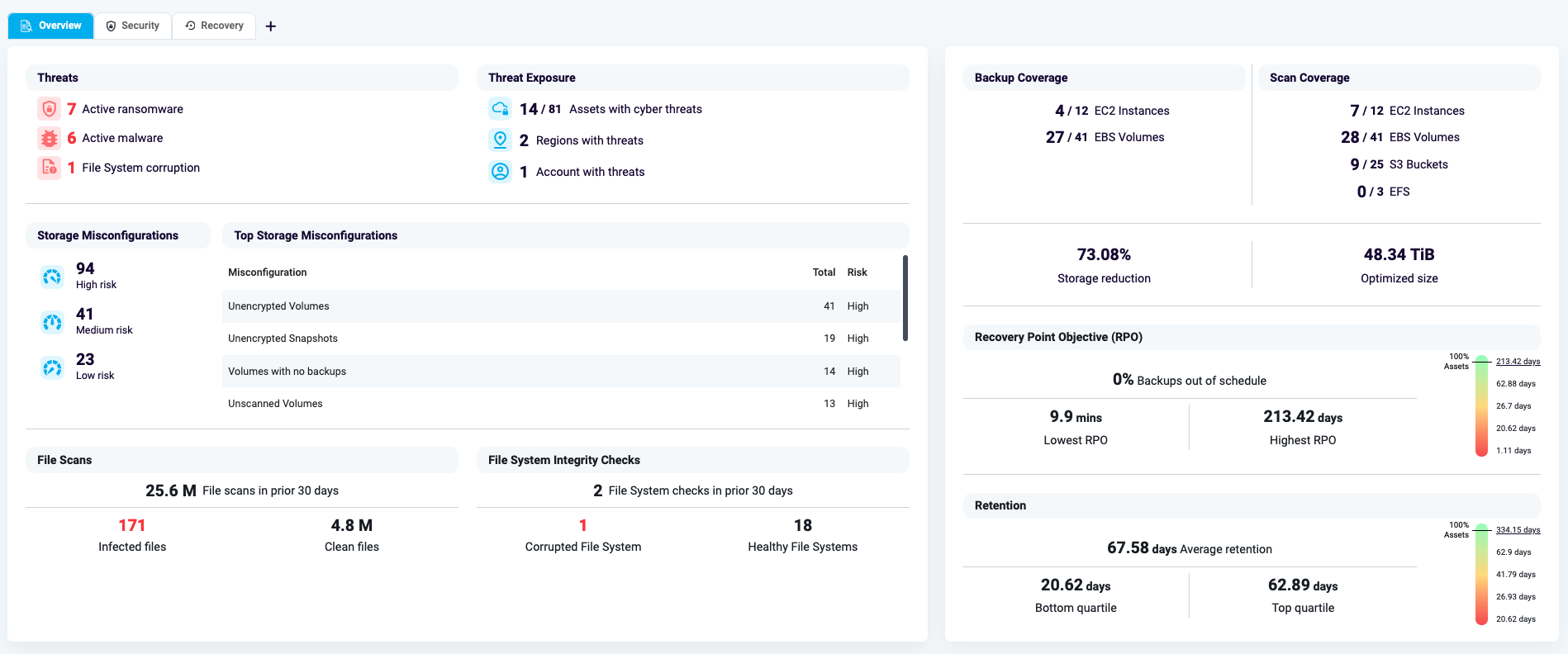
Figure 1: Overview Dashboard
Dashboard or the Data Resilience Control Center provides an at-a-glance view of the high-level metrics such as Threat Exposure, RPO, Backup Coverage etc.

Figure 2.1: Threats
First widget on the left is focused on threats.
Threats widget consists of 2 parts: Threats and Threat Exposure. Threats section contains 3 kinds of possible threats: Active ransomware, Active malware and File System corruption.
Threat Exposure reflects the % of assets that have cyber threats, the number of accounts and regions affected.

Figure 2.2: Assets with Active Threats
If you click on any of the sections, you’ll be redirected to a page with the list of assets containing that kind of active threat.

Figure 3.1: Storage Misconfigurations
Storage Misconfigurations widget gives you visibility into some potential issues that have been discovered within the accounts connected to Elastio. The misconfigurations are broken down into High, Medium and Low risk. Right next to the breakdown you can see a list of identified misconfigurations.
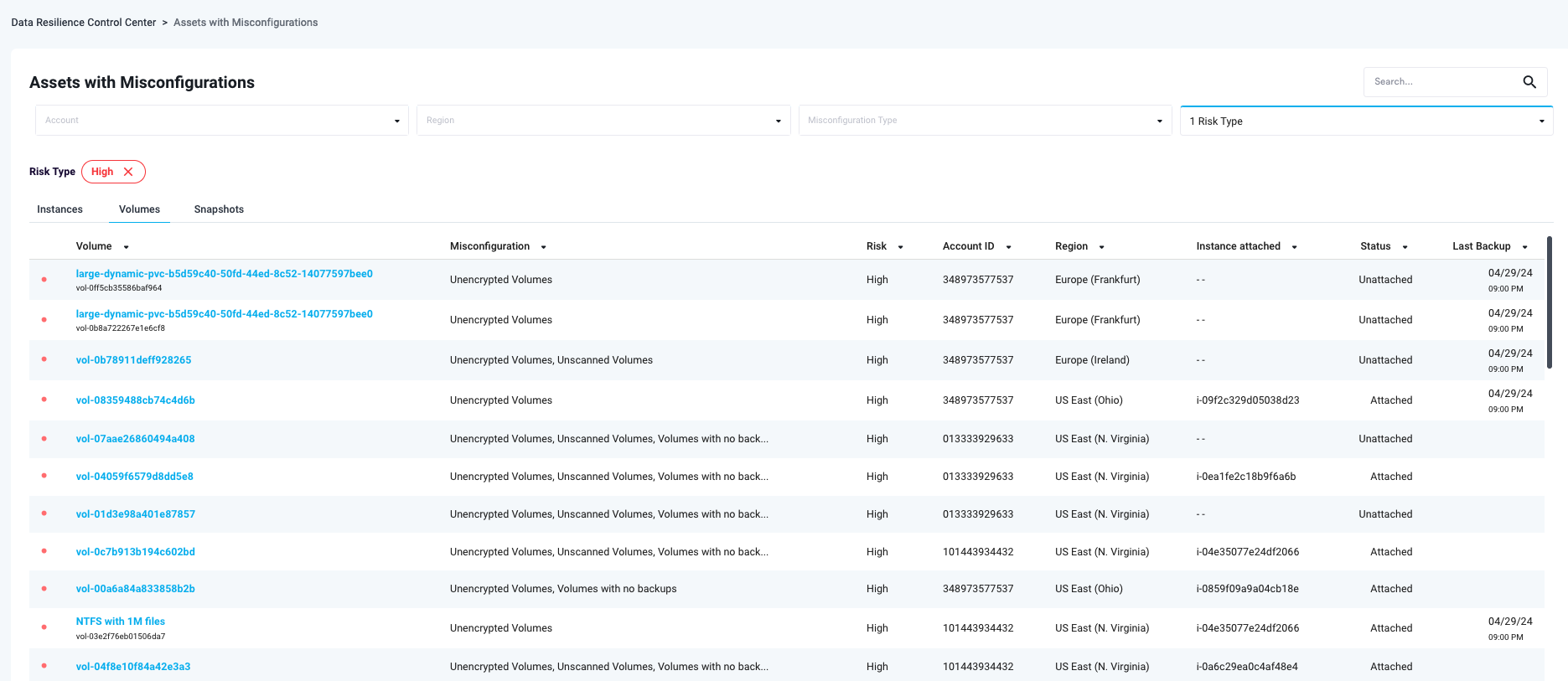
Figure 3.2: Assets with Misconfigurations
Clicking on the misconfiguration type will redirect you to the page containing a list of all assets containing these misconfigurations.

Figure 4: File Scans and File System Integrity Checks
The last widget on the left focuses on File Scans and File System Integrity Checks. You can see the number of files scanned in the last 30 days, the number of infected and clean files. The File System Integrity Checks section shows the number of file system checks performed alongside the number of corrupted and healthy file systems identified.
Moving to the right of the dashboard, you can see 3 more widgets: Backup and Scan Coverage, Recovery Point Objective (RPO), and Retention.
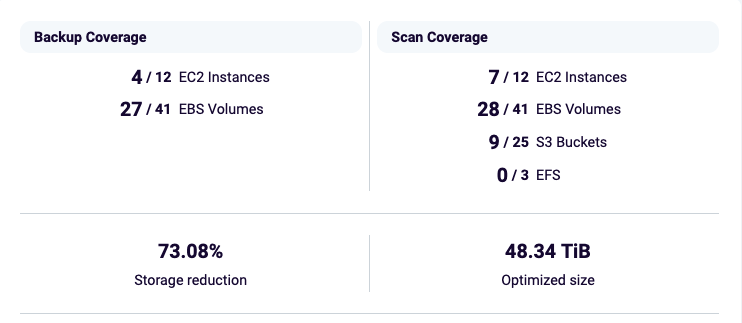
Figure 5: Backup Coverage and Scan Coverage
Backup Coverage widget provides an insight into how well the environment is protected. It displays the number of protected EC2 instances and EBS volumes compared to the total numbers, as well as storage reduction percentage and the optimized size of the backed up data.
Scan Coverage widget presents you with the number of EC2 instances, EBS volumes, S3 buckets and AWS EFS that are being scanned by Elastio compared to the total number of said resources discovered in the connected AWS accounts.
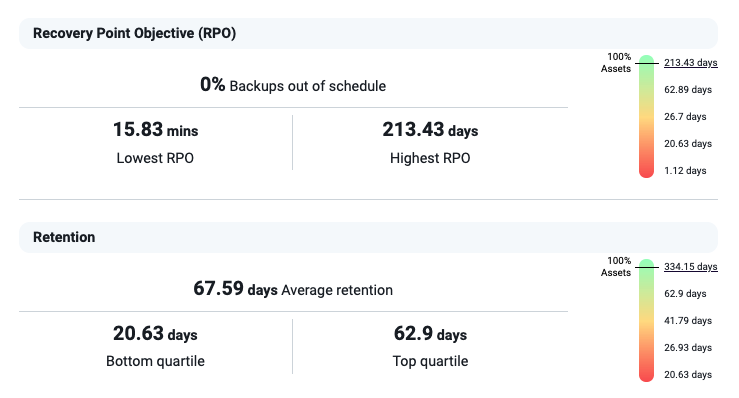
Figure 6: RPO and Retention
Recovery Point Objective is the amount of assets that were backed up within the pre-defined backup window. On this widget, you can see the % of assets that are out of schedule, as well as the highest and lowest RPOs. All aforementioned values are clickable and will redirect you to a page containing a list of assets with the selected value. The scale on the right can be clicked to view the percentage of assets with different RPO values.
Retention widget displays the average retention in days, alongside bottom and top quartile average retention values. Retention values are based on the age of the oldest retained recovery point for each asset. Clicking the scale on the right gives more insight into how assets are broken down into quartiles.
Security Dashboard
Security Dashboard provides you with some useful data on the security of your infrastructure. It displays metrics like the number of ransomware and malware threats detected, as well as storage misconfigurations and scan coverage.
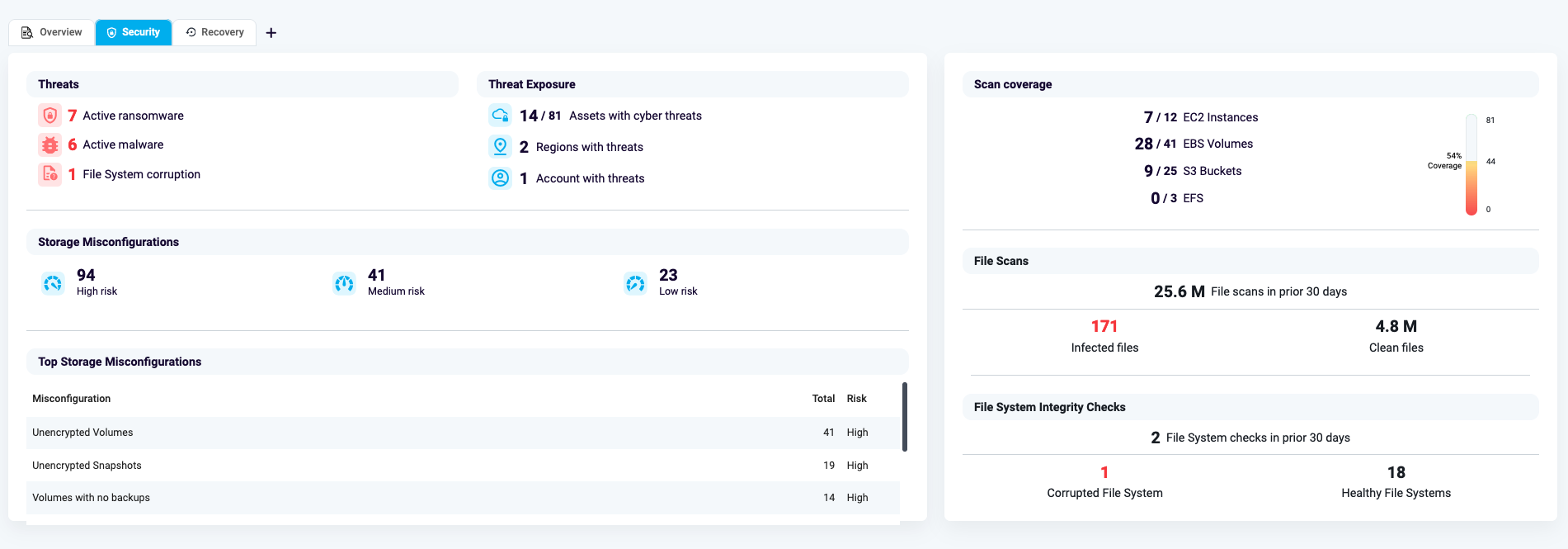
Figure 7: Security Dashboard
Threats widget consists of 2 parts: Threats and Threat Exposure. Threats section contains 3 kinds of possible threats: Active ransomware, Active malware and File System corruption.
Threat Exposure reflects the % of assets that have cyber threats, the number of accounts and regions affected. If you click on any of the sections, you’ll be redirected to a page with the list of assets containing that kind of active threat.
Storage Misconfigurations widget gives you visibility into some potential issues that have been discovered within the accounts connected to Elastio. The misconfigurations are broken down into High, Medium and Low risk. Right next to the breakdown you can see a list of identified misconfigurations. Clicking on the misconfiguration type will redirect you to the page containing a list of all assets containing these misconfigurations.
Scan Coverage widget presents you with the number of EC2 instances, EBS volumes, S3 buckets and AWS EFS that are being scanned by Elastio compared to the total number of said resources discovered in the connected AWS accounts.
File Scans represents the number of files scanned in the last 30 days, the number of infected and clean files.
The File System Integrity Checks section shows the number of file system checks performed alongside the number of corrupted and healthy file systems identified.
Recovery Dashboard
Recovery Dashboard view allows you to assess the ability to recover of the environments linked to Elastio as Sources.
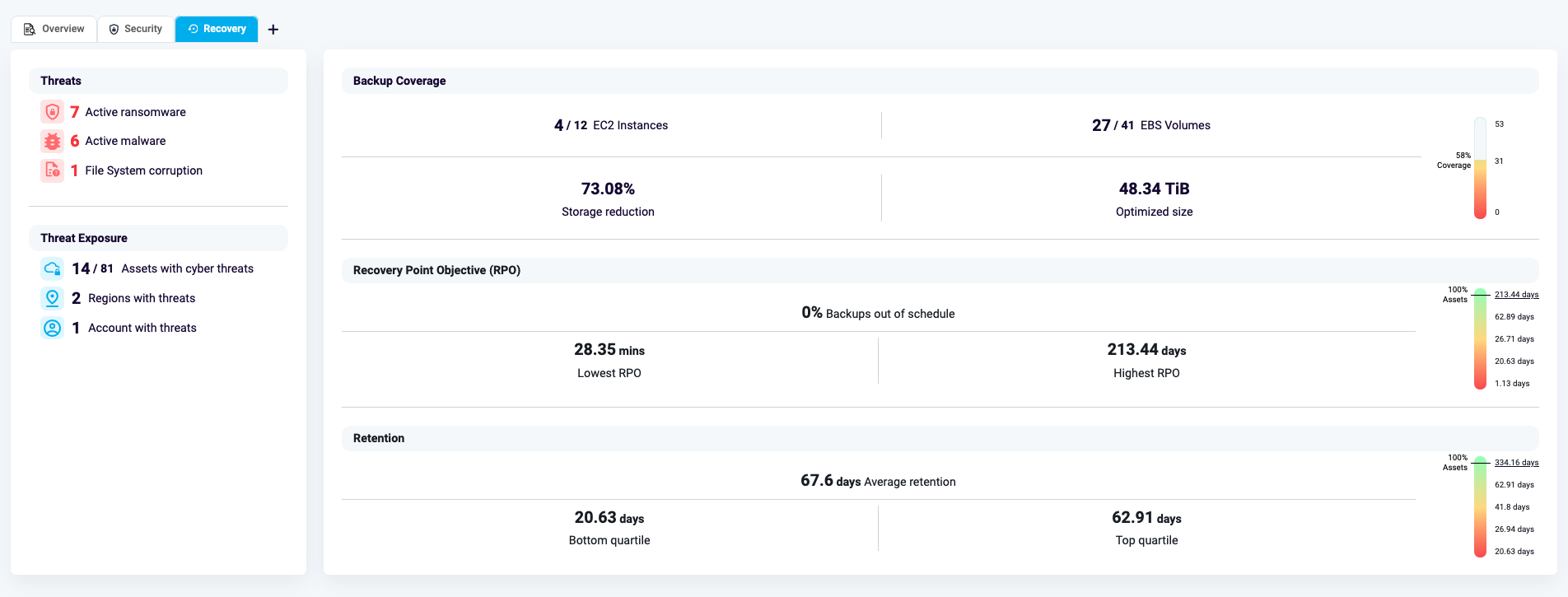
Figure 7: Recovery Dashboard
Threats widget consists of 2 parts: Threats and Threat Exposure. Threats section contains 3 kinds of possible threats: Active ransomware, Active malware and File System corruption.
Threat Exposure reflects the % of assets that have cyber threats, the number of accounts and regions affected. If you click on any of the sections, you’ll be redirected to a page with the list of assets containing that kind of active threat.
Backup Coverage widget provides an insight into how well the environment is protected. It displays the number of protected EC2 instances and EBS volumes compared to the total numbers, as well as storage reduction percentage and the optimized size of the backed up data.
Recovery Point Objective is the amount of assets that were backed up within the pre-defined backup window. On this widget, you can see the % of assets that are out of schedule, as well as the highest and lowest RPOs. All aforementioned values are clickable and will redirect you to a page containing a list of assets with the selected value. The scale on the right can be clicked to view the percentage of assets with different RPO values.
Retention widget displays the average retention in days, alongside bottom and top quartile average retention values. Retention values are based on the age of the oldest retained recovery point for each asset. Clicking the scale on the right gives more insight into how assets are broken down into quartiles.
Add New Dashboard View
In order to provide a more granular view of the assets health across the organization, Elastio has introduced additional customizable Dashboard views. This way you can get analytics on certain parts of your infrastructure, such as specific accounts, regions, criticality and even organization departments.
To add a new Dashboard view, go to the Dashboard page of your tenant, and press the “+” button next to the “Recovery” tab header.

Figure 8: Add new dashboard view
On the page that opens, select a name for the new Dashboard view. You’ll have several options to limit the view by. first, you have to select the view option: Recovery Points, Security or Backups & Scans, Then, select AWS account(s) and (optionally) AWS region(s). Additionally, you can filter assets by tags.Adding your tags, you can use “and” or “or” to make the filtering more granular. You can also exclude assets by tags. Exclusion works similarly to inclusion through “and” or “or” operator.
Once you have selected all the settings, press the “Create new view” button. This view will appear to the right of the default “Recovery” tab on the Dashboard page.